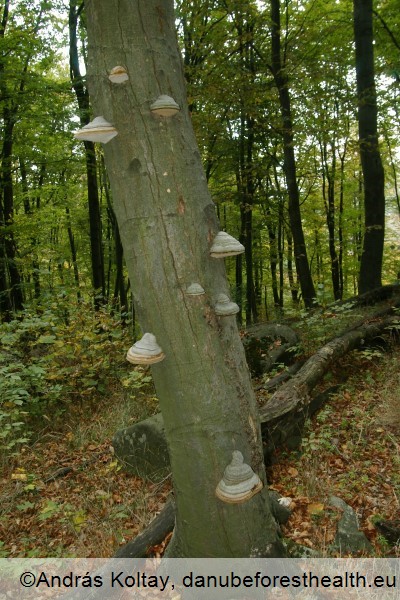Fungi
Tinder fungus
Fomes fomentarius
Nikica Ogris, Thomas Cech
|
|

Fig. 1. Fruiting bodies
DETECTION PERIOD:
during the whole year
DESCRIPTION:
This is a stem decay fungus, invading the wood of weakened trees via bark wounds or broken branches and causing a white rot. Tinder fungus is conspicuous because of its hoof-shaped fruit bodies, which can continue growing for many years. The fruit bodies are 10–50 cm across, pale brown, or grey to blackish or often brownish when young, and the domed upper surface has raised zones. The crust is very hard, 1–2 mm thick and covers a yellow-brown, tough but rather soft fibrous trama, below which layers of brown tubes are attached. Young fruiting bodies are characterized by a soft, tow-like, and marmorized tissue at the point of insertion at the substrate. Pieces of the fruiting body put into KOH give a dark red stain. In the decayed wood the Tinder fungus produces a white, leathery and dense mycelial tissue of several mm thickness. From spring to summer, vast numbers of basidiospores are released and carried away in air currents.
HABITAT:
Occurring mainly on beech, and less often on birch, alder, and hornbeam. Furthermore, on oaks, poplars, maples, cherries, hickory, linden, willows, alders; rarely on conifers.
STATUS:
Spread throughout Europe.
IMPACT:
The fungus reduces the timber value of trees that are already weakened or diseased. It is a weak parasite. However, it carries an important role as wood decomposer. If a large volume of wood is decayed, the stability of the stem is reduced so that it may snap in stormy weather.
SIMILAR SPECIES:
None
|